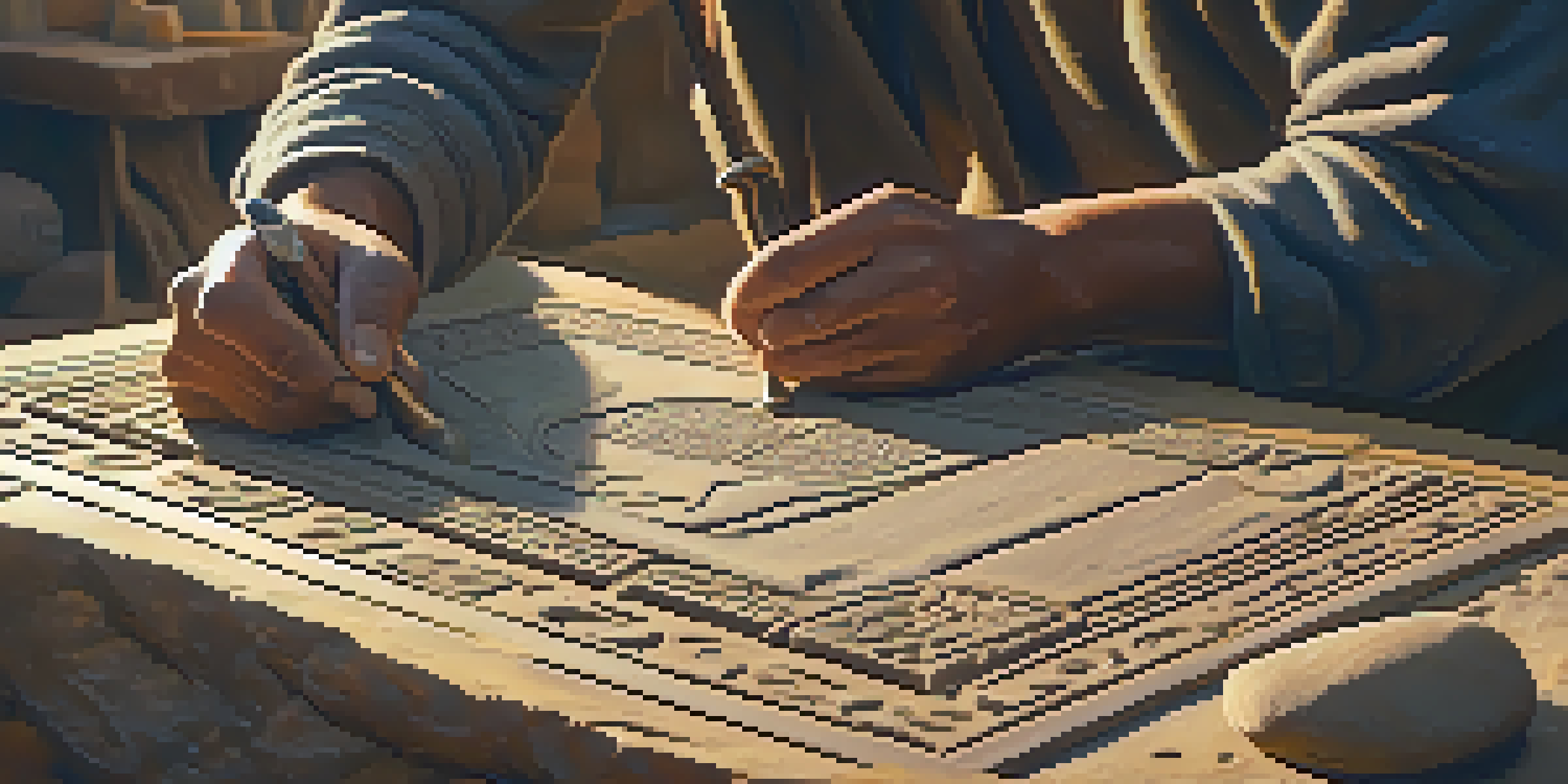Historical Stone Carving Techniques: Craftsmanship Through Time

The Ancient Origins of Stone Carving Techniques
Stone carving traces its roots back to ancient civilizations, where artisans used rudimentary tools to create stunning works of art. These early techniques involved chiseling and pecking, drawing inspiration from nature and religious beliefs. For instance, the Egyptians meticulously carved intricate hieroglyphs into their tombs, showcasing both their craftsmanship and cultural significance.
Art is the most beautiful of all lies.
As civilizations advanced, so did their stone carving methods. The introduction of more sophisticated tools allowed artisans to achieve greater precision and detail in their sculptures. The Greeks, for example, perfected the art of marble carving, creating lifelike figures that captured the beauty of the human form, influencing artists for generations to come.
Overall, the ancient origins of stone carving set the foundation for future techniques, blending practicality with artistry. This legacy of creativity continues to inspire modern craftsmen, proving that the essence of stone carving is timeless.
Tools of the Trade: Traditional Carving Instruments
The tools used in stone carving have evolved over the centuries, yet many traditional instruments remain essential today. Artisans typically rely on chisels, hammers, and rasps, each serving a specific purpose in the carving process. For example, a point chisel is used for rough shaping, while a flat chisel smooths surfaces and adds finer details.

Aside from hand tools, the introduction of powered tools in the 19th century revolutionized stone carving. Electric saws and pneumatic hammers made it easier for craftsmen to work with harder stones and complete projects more efficiently. However, many artisans still prefer hand tools for their ability to provide greater control and a personal touch to their work.
Ancient Techniques Shape Craft Today
The foundational techniques of stone carving, originating from ancient civilizations, continue to influence modern artisans.
This blend of traditional and modern techniques showcases the adaptability of stone carvers. Whether using ancient tools or contemporary machines, the artistry behind stone carving remains a labor of love.
Regional Variations in Stone Carving Techniques
Stone carving techniques vary widely across different cultures and regions, each influenced by local materials and traditions. For instance, the intricate stone carvings of India, seen in the temples of Khajuraho, reflect a unique blend of religious devotion and artistic expression. These sculptures often depict deities and mythological scenes, showcasing the region's rich heritage.
The stone is not a material. It is a spirit.
In contrast, the stone carvings of the Mediterranean region tend to emphasize realism and human figures. The Romans, for example, adopted and adapted Greek techniques, creating detailed busts and reliefs that celebrated their emperors and gods. This blending of styles further enriched the art of stone carving throughout history.
These regional variations highlight the diverse ways artisans have approached stone carving, allowing each culture to leave its mark on the craft. By studying these differences, we can appreciate the global tapestry of stone carving artistry.
The Role of Stone Carving in Architecture
Stone carving has played a crucial role in architecture, serving as both structural and decorative elements in buildings. From the grand columns of ancient temples to the ornate facades of Gothic cathedrals, carved stone has been used to convey beauty and strength. For example, the intricate carvings on the Notre-Dame Cathedral in Paris tell stories of faith and history.
Moreover, stone carving often reflects the architectural style of its time, showcasing the evolution of design principles. The Renaissance period saw a revival of classical motifs, with architects and stone carvers collaborating to create harmonious structures that emphasized symmetry and proportion. This partnership between art and architecture has continued to shape our built environment.
Symbolism Enhances Cultural Storytelling
Stone carvings convey deep symbolism and meaning, reflecting the values and beliefs of different cultures.
In essence, stone carving is not just an art form but a vital aspect of architectural heritage. The enduring nature of stone ensures that these carved masterpieces continue to inspire awe and admiration, bridging the past with the present.
Symbolism and Meaning in Stone Carvings
Throughout history, stone carvings have conveyed deep symbolism and meaning, often reflecting the values and beliefs of a culture. For example, many ancient civilizations carved animals or deities into stone as a way to honor their gods or represent power. The intricate carvings found in Mayan temples, for instance, often depicted celestial events, highlighting their connection to the universe.
In some cultures, specific motifs carried particular meanings, serving as visual language to communicate ideas. The use of geometric patterns in Islamic art, for example, symbolizes the infinite nature of creation, while also serving to beautify sacred spaces. These symbolic elements elevate stone carvings beyond mere decoration, making them a vital part of cultural storytelling.
Ultimately, the symbolism embedded in stone carvings enriches our understanding of human history and creativity. Each carved piece serves as a testament to the beliefs and aspirations of the people who created it, allowing us to connect with those who came before us.
The Preservation of Historic Stone Carvings
As time passes, many historic stone carvings face the threat of erosion, pollution, and neglect. Preservation efforts are crucial to maintaining these cultural treasures for future generations. Organizations and artisans work tirelessly to restore and protect these works, using techniques that respect the original craftsmanship while ensuring durability.
For instance, some restorers utilize gentle cleaning methods and compatible materials to repair damaged carvings without compromising their integrity. This careful approach requires a deep understanding of the original materials and techniques used by the artisans of the past. By embracing both science and artistry, preservationists can breathe new life into these historic pieces.
Preservation Efforts Safeguard Heritage
Preserving historic stone carvings is vital for maintaining cultural heritage and fostering appreciation for the artistry involved.
Preserving stone carvings not only safeguards artistic heritage but also fosters a greater appreciation for the skill involved in their creation. As we work to protect these invaluable works, we ensure that the stories they tell continue to resonate through time.
Modern Innovations in Stone Carving Techniques
In recent years, modern technology has introduced innovative techniques to the world of stone carving. CNC (Computer Numerical Control) machines, for example, allow artisans to create intricate designs with remarkable precision and speed. This technology can replicate complex patterns that would be time-consuming to carve by hand, opening new possibilities for artists.
However, while technology enhances efficiency, many contemporary stone carvers still value traditional methods. The tactile experience of hand carving remains irreplaceable, as it allows for personal expression and creativity. This blend of old and new techniques offers a unique perspective on how stone carving continues to evolve.

Ultimately, modern innovations in stone carving reflect a dynamic art form that honors its rich history while embracing change. As artisans explore new ways to engage with stone, the legacy of craftsmanship remains strong, ensuring that this timeless art continues to thrive.